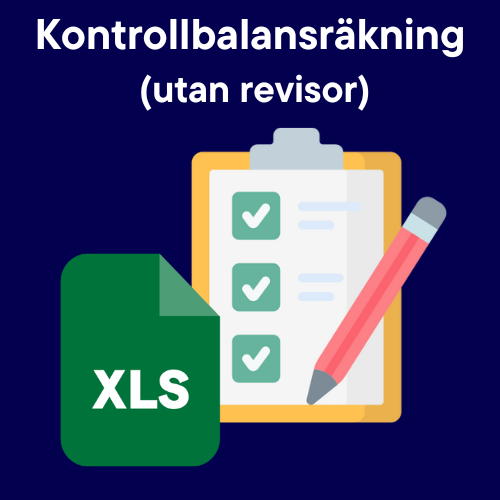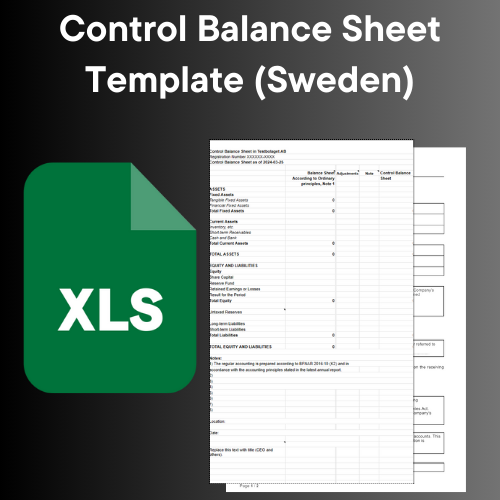Control balance sheet - What is the difference between K2/K3 companies?
Share
Control balance sheet - What is the difference between K2/K3 companies?
Table of Contents
- Differences between K2 and K3
- When You Must Prepare a Control Balance Sheet
- Why a Control Balance Sheet is Important
- Summary
Differences between K2 and K3
Yes, there are differences between making a balance sheet according to K2 and K3. K2 and K3 are two different standards for annual reports used in Sweden. Here are some of the essential differences between them:
- Scope: K2 (K2 regulations) is a simplified standard intended for smaller companies with limited complexity. K3 (the K3 regulations) is more extensive and is used by larger companies with higher complexity and scope.
- Requirements for accounting principles: K2 allows simplified accounting principles and provides more flexibility for smaller companies to apply alternative valuation methods. On the other hand, K3 follows stricter accounting principles and usually requires the application of fair value for certain assets and liabilities.
- Format: The balance sheet may look different depending on whether the company applies K2 or K3. In K2, certain items can be reported in abbreviated form or collected under parent headings, while K3 usually requires more detailed accounting and specification of assets, liabilities and equity.
- Requirements for notes: The K3 regulations usually require more comprehensive notes to the annual report compared to K2. The notes must provide additional information about the company's financial position, results and cash flows, as well as report important information about applied accounting principles and uncertainties.
- Audit: K3 companies are more often subject to audit by external auditors compared to K2 companies. The audit of a K3 annual report involves a more in-depth examination of the company's financial reports and internal controls.
In summary, K2 and K3 are different standards that suit different types of businesses based on their size, complexity and regulatory requirements. When preparing balance sheets, companies must follow the specific requirements and guidelines prescribed by the standard they apply.
When You Must Prepare a Control Balance Sheet
A control balance sheet can be prepared in various situations for both K2 and K3 companies to assess the accuracy and reliability of the company's financial reporting. Here are some situations where it may be appropriate to prepare a control balance sheet:
For K2 companies:
- Before the annual report: Before completing the annual report, it may be appropriate to make a trial balance to ensure that the accounting is correct and that no material errors have been overlooked.
- Before audit: If the K2 company chooses to have an auditor review its annual report, a control balance sheet can be drawn up as a preparatory step for the audit. This helps identify any errors or discrepancies that may need to be corrected before the audit begins.
- Before external reporting: If the K2 company must report to external stakeholders, such as banks or investors, a control balance sheet can be useful to ensure that the company's financial reporting is reliable and complete.
For K3 companies:
- Before the annual report: As for K2 companies, a control balance sheet can be drawn up before the annual report to ensure the accuracy of the accounting and to identify any errors or deviations.
- Before audit: As K3 companies are more often subject to audit by external auditors, a control balance sheet can be drawn up as a preparatory step before the audit to identify and correct any problems in the accounting.
- Before deciding on dividends or capital allocation: Before a K3 company decides to distribute dividends to shareholders or make capital allocations, a control balance sheet can be useful to assess the company's financial position and available resources.
Why a Control Balance Sheet is Important
Regardless of company category, a control balance sheet is a useful tool to ensure that the company's financial reporting is reliable and complies with applicable accounting principles and laws. It helps to detect and correct any errors or discrepancies before they are presented to stakeholders or auditors.
Summary
Yes, there are differences between making a balance sheet according to K2 and K3. K2 and K3 are two different standards for annual reports used in Sweden. Here are some of the essential differences between them:
- Scope: K2 (K2 regulations) is a simplified standard intended for smaller companies with limited complexity. K3 (the K3 regulations) is more extensive and is used by larger companies with higher complexity and scope.
- Requirements for accounting principles: K2 allows simplified accounting principles and provides more flexibility for smaller companies to apply alternative valuation methods. On the other hand, K3 follows stricter accounting principles and usually requires the application of fair value for certain assets and liabilities.
- Format: The balance sheet may look different depending on whether the company applies K2 or K3. In K2, certain items can be reported in abbreviated form or collected under parent headings, while K3 usually requires more detailed accounting and specification of assets, liabilities and equity.
- Requirements for notes: The K3 regulations usually require more comprehensive notes to the annual report compared to K2. The notes must provide additional information about the company's financial position, results and cash flows, as well as report important information about applied accounting principles and uncertainties.
- Audit: K3 companies are more often subject to audit by external auditors compared to K2 companies. The audit of a K3 annual report involves a more in-depth examination of the company's financial reports and internal controls.


